Accountability
Corporate Governance
- The Board believes that high standards of corporate governance are intrinsic to Amlin’s culture and values:
- They are central to fulfilling many of its core values stated earlier in this Annual Report, such as integrity, professional excellence and sustainability.
- They underpin the objectivity of such processes as insurance reserving, risk management, balance sheet and investment management, the design and operation of executive remuneration and succession planning.
- They are the basis for the accountability of executive management to the Board and of the Board to shareholders.
Board Corporate Governance Statement
Board composition and independence
During the year the Board of Amlin plc (the Board or plc Board) comprised: the Chairman, at different times either five or six other non-executive directors (NEDs), of whom at least five at any time were classified as independent, and four executive directors. The only changes to the Board during the year were the retirement of the one non-independent nonexecutive, Mr Tom Kemp, at the AGM on 24 May 2007, and the appointment with effect from 1 December 2007 of Mr Martin (Marty) Feinstein as a sixth independent non-executive director. Mr Buchanan served as senior independent nonexecutive director throughout the year. Biographical details of all the current directors are set out on here.
The non-executive Chairman was independent on his appointment in 1998 but, as Chairman, is not classified as independent. Apart from Mr Kemp (who was not independent by virtue of his crossdirectorship with Montpelier Re, with which the Company has in the past had a material reinsurance relationship), all the other non-executive directors during the year and in 2008 to date are determined by the Board as being independent in character and judgement with no relationships or circumstances which are likely to affect, or could appear to affect, the director’s judgement.
Mr Joslin was until 2002 Vice Chairman of State Farm Mutual Automobile Insurance Company (State Farm), which is disclosed as a 5.5% shareholder in the Company. In view of the length of time since his relationship with State Farm ended, he was classified as independent throughout the year. Mr Mylvaganam was first elected to the Board by shareholders in 1999 (having been appointed to the Board the previous September). Accordingly, he is being proposed for re-election to the Board at the AGM to be held in April 2008 for a term of office of one year only, on the basis that he will relinquish his Committee appointments for which independence is required later in 2008.
Board membership at 31 December 2007
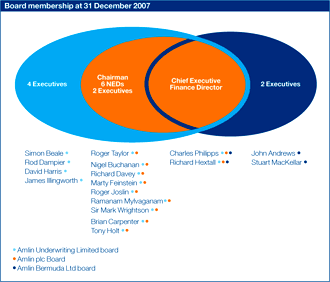
Click here for full sized image
Regulated subsidiaries within a Group framework
Each of the Group’s business platforms – Lloyd’s and Bermuda – have their own regulated Boards: those of Amlin Underwriting Limited (AUL), as the managing agent for the Group’s Lloyd’s syndicate, and Amlin Bermuda Ltd (ABL) respectively. As the plc Board has overall responsibility to shareholders and other stakeholders for the Group’s operations, it is at the same time necessary for Board Committees such as the Audit and Nomination Committees to be able to operate effectively in relation to the whole Group.
Amlin has addressed this issue, and the wish to avoid needless duplication between Amlin plc and AUL board business, both by the memberships of the three boards (illustrated in the figure below) and by the structure of Committee responsibilities at both board and executive management levels. As all plc directors are members of the AUL board, business reporting by AUL management is made to that board with no need for repetition at the plc Board. The latter is then able to concentrate more on strategic and longer term issues. The accountability of the ABL board to the plc Board operates differently. It operates independently in Bermuda and no decisions are made at the plc Board other than in its capacity as shareholder. Fuller operational reports on ABL than on AUL are then made to the plc Board in addition to reports on a Group level.
Board and Board Committee Structure
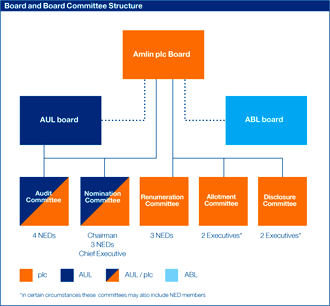
Click here for full sized image
The operation of the Audit and Nomination Committees as committees of the AUL as well as the plc Board enables those Committees to report directly to AUL the conclusions of its reviews of matters that are that board’s regulatory responsibility. These include Syndicate 2001’s reserving and Individual Capital Assessment, controls relating to all business written from the UK, and succession planning of underwriters and key AUL support roles. The boards of the other regulated companies in the Group, service companies that obtain business for Syndicate 2001, also report to the AUL board. In the case of ABL, its reporting continues in the traditional manner through the parent.
As part of the two annual Board evaluations conducted since changes were instituted in 2006, the effectiveness of this board and committee structure has been reviewed and the conclusion reached that it is working effectively in meeting both business and regulatory needs.
Corporate governance within the executive structure
Board level corporate governance is only the most visible aspect of a review and decision-making structure that goes much deeper. The Group and AUL executive team has many internal processes to operate and decisions to make, all of which require clearly defined authorities and processes. The structure in the UK of executive decision making, review and consultation, and its interaction with relevant board Committees, is illustrated in the chart opposite.
At the centre of the executive function is the Executive Management Group (EMG), of the nine most senior UK-based executives (the executive directors of AUL plus the head of HR), led by the Chief Executive. Some committees of executives report directly into the Board level governance structure, such as the Reserving Committee (a committee of the AUL board), and others report to EMG.
The business functions themselves are all described in more detail in the Review section of the Annual Report but the above governance structure shows that differing arrangements have been adopted to ensure the most appropriate management and accountability of different aspects of the business. Some examples of these follow below.
UK Executive Committee Structure
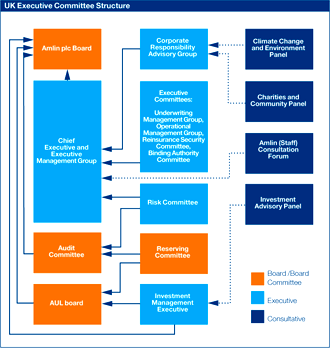
Click here for full sized image
Reserving
The ultimate responsibility for the Group’s reserving is that of the boards but it is also important that the process whereby executive management reaches the proposed reserving decisions is objective and robust. Hence AUL’s Reserving Committee, which reviews and finalises the preliminary reserving conclusions each quarter, reports on reserving to the Audit Committee (twice yearly) and the AUL Board (quarterly). The Reserving Committee is chaired by the Chief Executive. Its members include the Finance Director, the four divisional underwriters and the Chief Risk Officer. It receives internal actuarial reports from the Risk Assessment & Monitoring department reviewing the consistency of the key reserving judgements. In the case of ABL, its board effectively acts as the reserving committee, receiving reports direct from its local management, which has the benefit of advice and analysis provided by the Group Risk Assessment & Monitoring department.
Risk management
There is a clear line of responsibility for risk management from business managers to the executive Risk Committee and, from there, to the Audit Committee reporting to both the AUL and plc boards. The Risk Committee also reports to EMG in order to ensure that recommendations for risk assessment, control and mitigation are carefully considered and acted upon at executive level. Further details of the Group’s Risk Management is set out in the Review section of the Annual Report and the conclusions of the Board’s review of internal control is set out in the 'Board internal control statement' later in this report.
Investments
The setting and execution of the Group’s investment strategy has its own hierarchy of responsibilites. The relevant boards (AUL for syndicate funds, which includes its underwriting and capital assets, ABL for its own funds, and Amlin plc for surplus capital and a Group overview) are responsible for their own overall strategies. An Investment Management Executive including the Finance Director, Chief Executive and Chief Investment Officer has responsibility for important tactical decisions with day to day decisions being taken by the Chief Investment Officer. The executive is assisted in its decision making and recommendations to the boards by an Investment Advisory Panel (IAP) consisting of members of the Investment Management Executive plus three external investment experts. The whole process is governed by a comprehensive investment governance manual, which defines what decisions may be taken at what level. This has been refined over time so that, for instance, during 2007 fund manager monitoring (including receiving progress report presentations) was moved from the IAP to the Investment Management Executive, freeing up more time for the IAP to consider strategic asset allocation issues.
Corporate responsibility
The Chief Executive has Board level responsibility for all corporate responsibility matters. Until 2007 he was supported by a staff Charities Committee, a staff Environment Committee and a Health & Safety Committee, with no formal governance structures covering other aspects of corporate responsibility. In late 2007 following the completion of a review of our strategy and approach, we broadened the remit of the Charities Committee into a Charities and Community Panel and replaced the Environment Committee with a Climate Change and Environment Panel. These panels will both report to a new Corporate Responsibility Advisory Group, which will review the adequacy of the Group’s overall corporate reponsibility activities. Rather than being made up principally of staff representative committees, this structure will have greater managerial input, aiming to provide more focus and strategic direction, recognising the area’s increasing importance as a responsibility of management and the boards. A separate Corporate Responsibilitie report follows the corporate governance reports.
Board and Committee meetings and attendance
The plc Board held six regular Board meetings in 2007 (2006: five) and one two-day planning and strategy session (2006: one). Three Board meetings were held during the year to consider specific corporate matters or transactions (2006: nil). The subsidiary operating boards met quarterly. The attendance of each director at plc Board meetings (out of ten possible meetings, including the planning and strategy session) are shown below. All of the committee members, whose attendance is also shown below, served on relevant committees throughout the year and in 2008 to date.
Board meeting attendance in 2007
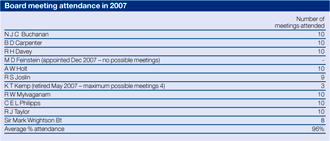
Click here for full sized image
Committee membership and meeting attendance in 2007
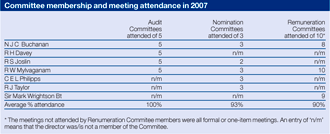
Click here for full sized image
